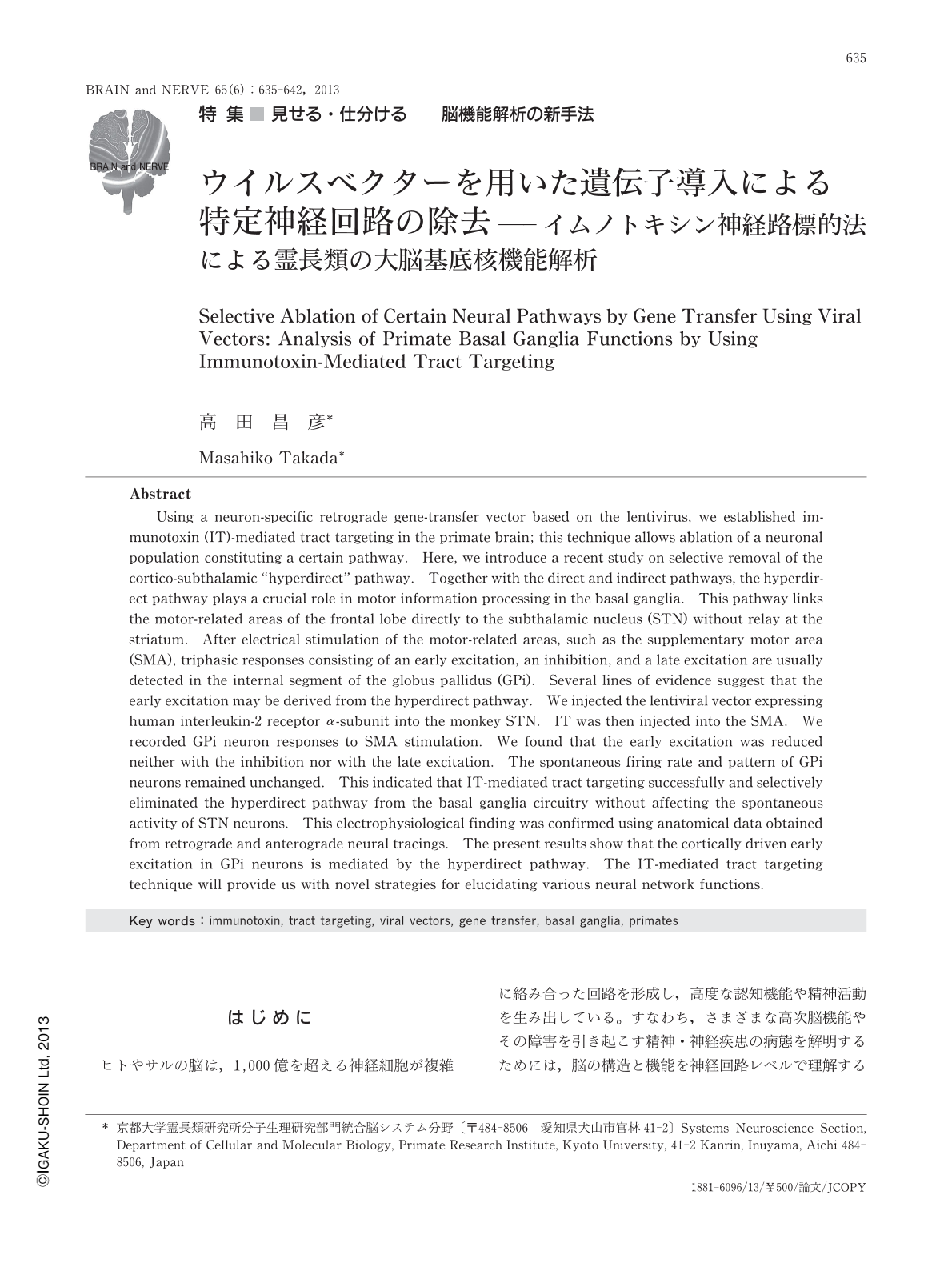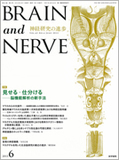Japanese
English
- 有料閲覧
- Abstract 文献概要
- 1ページ目 Look Inside
- 参考文献 Reference
はじめに
ヒトやサルの脳は,1,000億を超える神経細胞が複雑に絡み合った回路を形成し,高度な認知機能や精神活動を生み出している。すなわち,さまざまな高次脳機能やその障害を引き起こす精神・神経疾患の病態を解明するためには,脳の構造と機能を神経回路レベルで理解することが本質的である。また,精神・神経疾患の効果的な治療法を確立するためにも,疾患の病態を引き起こす責任ニューロンとそれらで形成される神経回路に対するアプローチが欠かせない。例えば,パーキンソン病などの神経疾患の遺伝子治療を適切に行うためには,複雑な神経回路の中から疾患の病態に関係した特定の回路を同定し,それを標的(ターゲット)にする必要がある。しかしながら,特定の神経回路に外来遺伝子を導入することはこれまで困難であった。
そこで,筆者らの研究グループでは,サル脳への遺伝子導入に適したウイルスベクターの開発,ターゲット領域へのベクター注入法の確立,さらに,それらを応用したサル脳への遺伝子導入実験に精力的に取り組んできた。すなわち,目的に合わせて作製したウイルスベクターをサルの脳内に微量注入することによって,部位特異的かつ時間特異的に外来遺伝子を導入したモデル動物を開発し,高次脳機能の解明と精神・神経疾患の克服を目指した研究が可能になる。
本稿では,遺伝子発現の特異性に基づいて特定の神経回路を形成するニューロンを選択的に除去する技術である,イムノトキシン神経路標的法について概説するとともに,これを利用して霊長類の大脳基底核機能の一端を明らかにした最近の研究成果を紹介する。
Abstract
Using a neuron-specific retrograde gene-transfer vector based on the lentivirus, we established immunotoxin (IT)-mediated tract targeting in the primate brain; this technique allows ablation of a neuronal population constituting a certain pathway. Here, we introduce a recent study on selective removal of the cortico-subthalamic "hyperdirect" pathway. Together with the direct and indirect pathways, the hyperdirect pathway plays a crucial role in motor information processing in the basal ganglia. This pathway links the motor-related areas of the frontal lobe directly to the subthalamic nucleus (STN) without relay at the striatum. After electrical stimulation of the motor-related areas, such as the supplementary motor area (SMA), triphasic responses consisting of an early excitation, an inhibition, and a late excitation are usually detected in the internal segment of the globus pallidus (GPi). Several lines of evidence suggest that the early excitation may be derived from the hyperdirect pathway. We injected the lentiviral vector expressing human interleukin-2 receptor α-subunit into the monkey STN. IT was then injected into the SMA. We recorded GPi neuron responses to SMA stimulation. We found that the early excitation was reduced neither with the inhibition nor with the late excitation. The spontaneous firing rate and pattern of GPi neurons remained unchanged. This indicated that IT-mediated tract targeting successfully and selectively eliminated the hyperdirect pathway from the basal ganglia circuitry without affecting the spontaneous activity of STN neurons. This electrophysiological finding was confirmed using anatomical data obtained from retrograde and anterograde neural tracings. The present results show that the cortically driven early excitation in GPi neurons is mediated by the hyperdirect pathway. The IT-mediated tract targeting technique will provide us with novel strategies for elucidating various neural network functions.

Copyright © 2013, Igaku-Shoin Ltd. All rights reserved.


